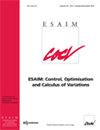Controllability of a Stokes system with a diffusive boundary condition
IF 1.2
3区 数学
Q4 AUTOMATION & CONTROL SYSTEMS
Esaim-Control Optimisation and Calculus of Variations
Pub Date : 2022-09-12
DOI:10.1051/cocv/2022057
引用次数: 2
Abstract
We are interested by the controllability of a fluid-structure interaction system where the fluid is viscous and incompressible and where the structure is elastic and located on a part of the boundary of the fluid's domain. In this article, we simplify this system by considering a linearization and by replacing the wave/plate equation for the structure by a heat equation. We show that the corresponding system coupling the Stokes equations with a heat equation at its boundary is null-controllable. The proof is based on Carleman estimates and interpolation inequalities. One of the Carleman estimates corresponds to the case of Ventcel boundary conditions. This work can be seen as a first step to handle the real system where the structure is modeled by the wave or the plate equation.具有扩散边界条件的Stokes系统的可控性
我们感兴趣的是流固相互作用系统的可控性,其中流体是粘性和不可压缩的,而结构是弹性的,位于流体域的一部分边界上。在本文中,我们通过考虑线性化和用热方程代替结构的波/板方程来简化该系统。我们证明了Stokes方程与热方程在其边界处耦合的对应系统是零可控的。证明是基于Carleman估计和插值不等式。其中一个Carleman估计对应于Ventcel边界条件的情况。这项工作可以看作是处理实际系统的第一步,其中结构是由波或板方程模拟的。
本文章由计算机程序翻译,如有差异,请以英文原文为准。
求助全文
约1分钟内获得全文
求助全文
来源期刊

Esaim-Control Optimisation and Calculus of Variations
Mathematics-Computational Mathematics
自引率
7.10%
发文量
77
期刊介绍:
ESAIM: COCV strives to publish rapidly and efficiently papers and surveys in the areas of Control, Optimisation and Calculus of Variations.
Articles may be theoretical, computational, or both, and they will cover contemporary subjects with impact in forefront technology, biosciences, materials science, computer vision, continuum physics, decision sciences and other allied disciplines.
Targeted topics include:
in control: modeling, controllability, optimal control, stabilization, control design, hybrid control, robustness analysis, numerical and computational methods for control, stochastic or deterministic, continuous or discrete control systems, finite-dimensional or infinite-dimensional control systems, geometric control, quantum control, game theory;
in optimisation: mathematical programming, large scale systems, stochastic optimisation, combinatorial optimisation, shape optimisation, convex or nonsmooth optimisation, inverse problems, interior point methods, duality methods, numerical methods, convergence and complexity, global optimisation, optimisation and dynamical systems, optimal transport, machine learning, image or signal analysis;
in calculus of variations: variational methods for differential equations and Hamiltonian systems, variational inequalities; semicontinuity and convergence, existence and regularity of minimizers and critical points of functionals, relaxation; geometric problems and the use and development of geometric measure theory tools; problems involving randomness; viscosity solutions; numerical methods; homogenization, multiscale and singular perturbation problems.
 求助内容:
求助内容: 应助结果提醒方式:
应助结果提醒方式:


